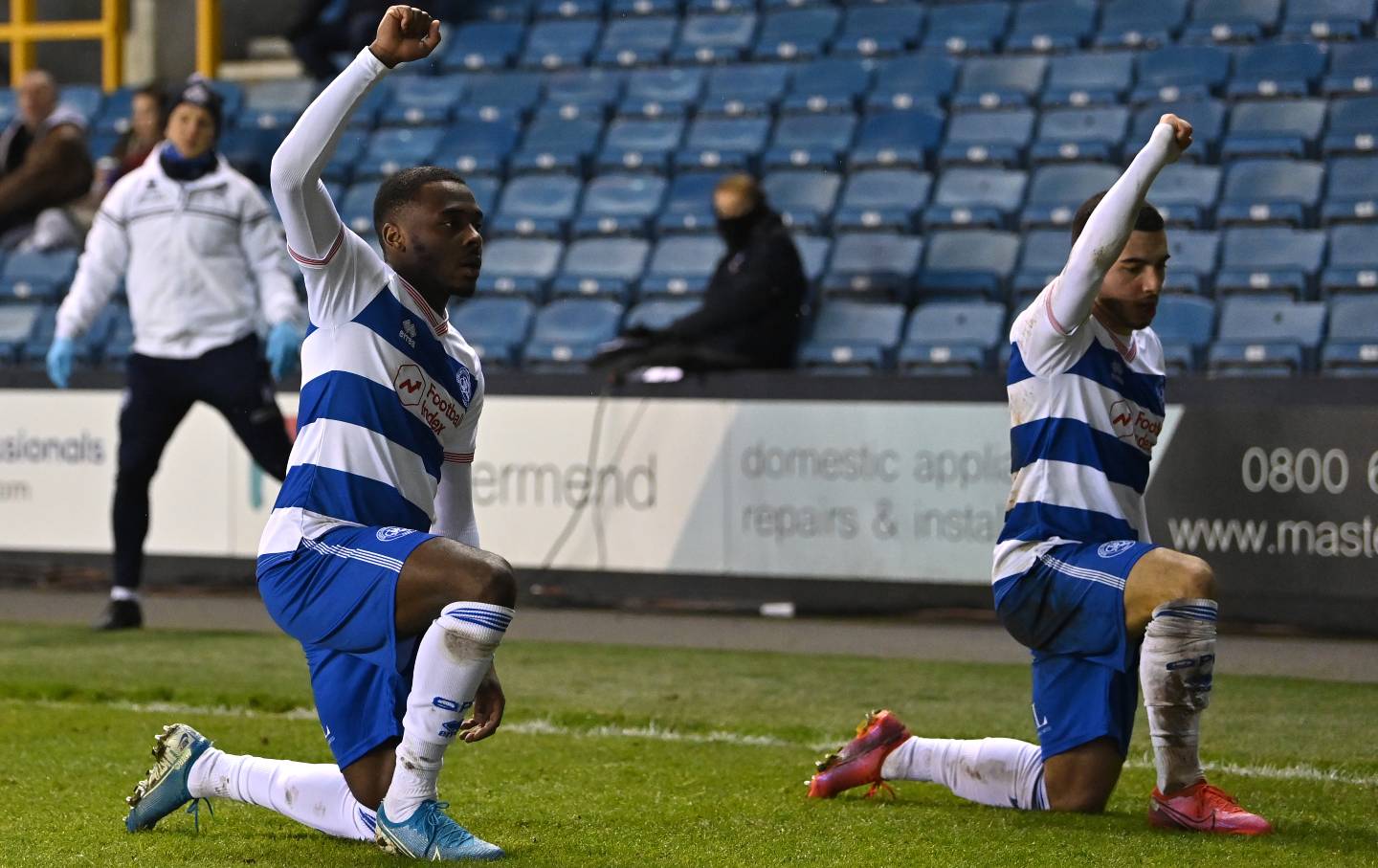
Ilias Chair, right, and Bright Osayi-Samuel of the Queens Park Rangers take a knee during the Sky Bet Championship match on December 8, 2020, in London, England. (Justin Setterfield / Getty)
As more athletes have chosen to take a knee during the National Anthem in protest of racism and police violence, some worry that the gesture may be losing its impact. When kneeling is approved by sports leagues and is practiced in an empty stadium, with no fear of a fan backlash, it can feel empty like an empty attempt at branding rather than the radical dissent it once was. As author Howard Bryant wrote, “Just call it for what it is: kneeling is a safe gesture now. No risk, no sanction. When it was a risk, very few people took it.” Or, as former NFL player Martellus Bennett put it, “Kneeling in 2020 don’t hit the same.”
Yet the power of kneeling returned with a vengeance this week in England. This roller coaster of a story starts last Saturday, when Millwall played Derby. The players from Millwall took a knee before the game, as has been their custom. But this was the first time they had done so in front of their fans. About 2,000 were allowed into the stadium because of the country’s lifting of some Covid protocols. Finally face to face with the kneeling players, a section of fans booed lustily.
In response to this bald-faced display, Millwall sheepishly backed down. The team announced that for their Tuesday game against the Queen’s Park Rangers, they would instead hold up a banner calling for “equality.” Players would also stand arm-in-arm in a “show of solidarity for football’s fight against discrimination.” They would take the aims of the BLM struggle—already watered down by team-sanctioned kneeling—and further dilute its message. Like the NFL, they would be taking a clarion call to end police violence and turn it into something Hallmark could have created.
This move by Millwall was immediately criticized as a “sedate” capitulation to the worst of their fan base. The racists had won. Not even empty gestures would be tolerated by the Millwall supporters, and the most hardcore among their ranks felt the thrill of political victory. In the words of soccer writer Leander Schaerlaeckens, “Millwall’s fans have a reputation for being England’s most racist following, which is quite the distinction to earn.” The Millwall supporters club defended the booing afterward in a statement where they claimed that they weren’t racist but instead just opposed the politics of those behind the Black Lives Matter movement. (Sound familiar?) Millwall management issued a rather toothless statement in response saying, “Millwall’s stance, as always, is that anybody found guilty of racial abuse is banned for life,” but took no action against either their supporters or anyone booing the kneeling gesture.
Yet then something truly remarkable happened during their game Tuesday against the Queen’s Park Rangers. After 23-year-old QPR midfielder and Moroccan national Ilias Chair scored a goal, he and his Nigerian teammate Bright Osayi-Samuel kneeled and raised their fists right in front of Millwall’s main supporters’ section. It was an act of defiance, not sanctioned by any management team. This action definitely “hit the same” as it did before kneeling became any kind of expression of faux-wokeness.
Many in the soccer community, especially those disgusted by the Millwall club’s capitulation to its most racist fans, welcomed the gesture. As soccer writer Elliot Ross tweeted, “QPR players celebrating their goal by taking the knee in front of the Millwall fans??? Inject it!!!”
What this entire imbroglio shows is that kneeling still has its incendiary, catalytic power when it is directed politically at those trying to shut down any kinds of conversation about police violence or racial inequity. When it is done at the behest of management trying to cynically appeal to young fans it becomes just another chapter in the long history of the commodification of dissent. But when it is done in the face of either fans, police, or other people in power, its message is utterly unmistakable.
I think what we have seen here is a preview of what is to come in the months ahead as fans are allowed into pro stadiums in the United States. If US players still choose to kneel, they may find that they need a degree of fortitude they did not have access to in an empty stadium. It’s the difference between marketing and rebellion.
Dave ZirinDave Zirin is the sports editor at The Nation. He is the author of 11 books on the politics of sports. He is also the coproducer and writer of the new documentary Behind the Shield: The Power and Politics of the NFL.